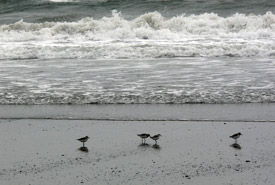Musquodoboit Harbour

Musquodoboit Harbour, Nova Scotia (Photo by NCC)
The Musquodoboit Harbour boasts a complex system of coastal islands, salt marshes, mudflats, barrier beaches, bogs, barrens and coastal forest. The Musquodoboit islands contain a variety of habitats, including old-growth coastal spruce forest, small ponds, heath barrens and sand dunes.
The 1,925-hectare (4,756-acre) Musquodoboit Harbour Outer Estuary was designated as a Ramsar Site in 1987. The Ramsar Convention on Wetlands is an intergovernmental treaty signed by 155 countries enlisted in a global effort to ensure the conservation of world-class wetlands. It is also recognized as an Important Bird Area (IBA) of international importance.
Musquodoboit Harbour at a glance
The Nature Conservancy of Canada (NCC) has secured 10 properties here, totalling 546 hectares (1,350 acres), protecting a significant area in the Musquodoboit Harbour.
In December 2012, NCC conserved five off-shore islands in the upper reaches of Musquodoboit Harbour in the Halifax Regional Municipality.
NCC announced it has protected the 16-hectare (39-acre) Mikes Islands — a cluster of five islands. The protected area is being named after Captain Mike Williams and his wife Ellen Williams as per their family's wish. The property was donated in memory of their late grandfather, Mike, a master mariner who raced schooners and was a deep-sea captain.
Mike's Islands provides critical habitat for migratory waterfowl, including American black duck and common merganser. It also protects habitat for a range of shorebirds, including semipalmated sandpiper and lesser yellowlegs. The area has also been known for its salmon runs.
In 2010, NCC protected Goose Point Island and another 55 hectares (135 acres) to this important conservation area. This island supports a number of terrestrial mammals, including white-tail deer, mink and otter. Its irregular shoreline is dotted with salt marshes and brackish and freshwater ponds. The island is a key component of the harbour's large estuary, thus providing important feeding and staging habitat for migratory waterfowl and shorebirds.
Bayers Island, acquired in 2009, was considered the third in the "triple crown" of the Martinique group of islands. Prior to that, NCC secured Gunners Island & Francis Nose Island. Bayers Island is actually a 32-hectare (79-acre) archipelago consisting of three main islands. The three islands are connected by barrier beaches and several smaller islands embedded within a shallow salt marsh system.
Conservation values
- Musquodoboit is a tidal inlet, largely enclosed by a barrier sand beach and many forested islands.
- Diverse coastal habitat types support 8,000 Canada geese during spring migration.
- Fall migration stop for more than 3,000 green-winged teals and hosts a winter population of over 2,000 American black ducks.
- The endangered piping plover also nests and breeds on Martinique Beach, one of the most popular beaches and the longest sandy beach in Nova Scotia.
- Bayers Island's coastal forest of spruce and balsam fir are ideal for bird species such as osprey, bald eagle and great blue heron, while its surrounding mudflats and eel-grass beds support vast numbers of staging waterfowl.
Threats
The primary threats to the ecological integrity of the Musquodoboit Harbour system are residential and recreational development, urban sprawl, unsustainable tourism activities and timber harvesting. These development pressures are particularly high due to its close proximity to the city of Halifax. We will continue to engage area land owners in a dialogue in hopes of securing further island properties to sustain this beautiful area.




